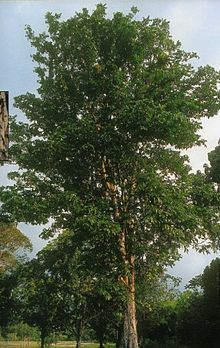Carapa guianensis
- Machine translation, like DeepL or Google Translate, is a useful starting point for translations, but translators must revise errors as necessary and confirm that the translation is accurate, rather than simply copy-pasting machine-translated text into the English Wikipedia.
- Do not translate text that appears unreliable or low-quality. If possible, verify the text with references provided in the foreign-language article.
- You must provide copyright attribution in the edit summary accompanying your translation by providing an interlanguage link to the source of your translation. A model attribution edit summary is
Content in this edit is translated from the existing Dutch Wikipedia article at [[:nl:Krappa]]; see its history for attribution. - You may also add the template
{{Translated|nl|Krappa}}to the talk page. - For more guidance, see Wikipedia:Translation.
| Carapa guianensis | |
|---|---|
 | |
Conservation status | |
| Scientific classification | |
| Kingdom: | Plantae |
| Clade: | Tracheophytes |
| Clade: | Angiosperms |
| Clade: | Eudicots |
| Clade: | Rosids |
| Order: | Sapindales |
| Family: | Meliaceae |
| Genus: | Carapa |
| Species: | C. guianensis |
| Binomial name | |
| Carapa guianensis | |
Carapa guianensis is a species of tree in the family Meliaceae, also known by the common names andiroba or crabwood.


Description
Andiroba is native to the Amazon and is widely used by the indigenous populations of the northern region of Brazil.[2] It grows in the Amazon region, Central America and the Caribbean. It is a tall tree with dense foliage and usually grows in the tropical rainforest along the edge of rivers.
Uses
The timber is used in furniture and flooring. While the wood is not classified as genuine mahogany, it is related to the mahogany family and is similar in appearance.[3]
The oil contained in the andiroba almond, known as crab oil or carap oil, is light yellow and extremely bitter. When subjected to a temperature below 25 °C, it solidifies, with a consistency like that of petroleum jelly. It contains olein, palmitin and glycerin.
The oil and fats of the almond are extracted and used for the production of insect repellent and compounds for traditional medicine.[2][4][5][6] It is used in Brazil to protect furniture from termites and other wood-chewing insects.
References
- ^ Rivers, M.C.; Barstow, M.; Mark, J. (2017). "Carapa guianensis". IUCN Red List of Threatened Species. 2017: e.T61794008A61794012. doi:10.2305/IUCN.UK.2017-3.RLTS.T61794008A61794012.en. Retrieved 11 May 2022.
- ^ a b Hammer, M. L.; Johns, E. A. (1993). "Tapping an Amazônian plethora: Four medicinal plants of Marajó Island, Pará (Brazil)". Journal of Ethnopharmacology. 40 (1): 53–75. doi:10.1016/0378-8741(93)90089-n. PMID 8246531.
- ^ Andiroba - Wood database
- ^ Roy, A; Saraf, S (2006). "Limonoids: Overview of significant bioactive triterpenes distributed in plants kingdom". Biological & Pharmaceutical Bulletin. 29 (2): 191–201. doi:10.1248/bpb.29.191. PMID 16462017.
- ^ De Mendonça, F. A.; Da Silva, K. F.; Dos Santos, K. K.; Ribeiro Júnior, K. A.; Sant'Ana, A. E. (2005). "Activities of some Brazilian plants against larvae of the mosquito Aedes aegypti". Fitoterapia. 76 (7–8): 629–36. doi:10.1016/j.fitote.2005.06.013. PMID 16253435.
- ^ Silva, O. S.; Romão, P. R.; Blazius, R. D.; Prohiro, J. S. (2004). "The use of andiroba Carapa guianensis as larvicide against Aedes albopictus". Journal of the American Mosquito Control Association. 20 (4): 456–7. PMID 15669392.














